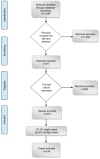Epidemiology and evolution of the diagnostic classification of factitious disorders in DSM-5
- PMID: 29270035
- PMCID: PMC5729833
- DOI: 10.2147/PRBM.S153377
Epidemiology and evolution of the diagnostic classification of factitious disorders in DSM-5
Abstract
A systematic search for all case reports and case series of adult patients with factitious disorders (FD) in the databases MEDLINE, Scopus, and PsycINFO was conducted. FD is a psychiatric disorder in which sufferers intentionally fabricate physical or psychological symptoms in order to assume the role of a patient, without any obvious gain. The clinical and demographic profile of patients with FD has not been sufficiently clear. Thus, the aims of this study were to outline a demographic and clinical profile of a large sample of patients with FD and to study the evolution of the position of FD in the Diagnostic and Statistical Manual of Mental Disorders. One thousand six hundred thirty-six records were obtained based on key search terms, after exclusion of duplicate records. Five hundred seventy-seven articles were identified as potentially eligible for the study, of which 314 studies were retrieved for full-text review. These studies included 514 cases. Variables extracted included age, gender, reported occupation, comorbid psychopathology, clinical presentation, and factors leading to the diagnosis of FD. In the sample, 65.4% of patients were females. Mean age at presentation was 33.5 years. A health care profession was reported most frequently (n=113). Patients were most likely to present in psychiatry, neurology, emergency, and internal medicine departments. The broad survey of sociodemographic profile of the sample has highlighted some important points for early diagnosis and early psychiatric treatment. The study showed that the patients did not meet Diagnostic and Statistical Manual of Mental Disorders-5 diagnostic criteria in 11.3% of cases.
Keywords: Munchausen syndrome; fabricated illness; factitious disorder; medically unexplained symptoms.
Conflict of interest statement
Disclosure The authors report no conflicts of interest in this work.
References
-
- American Psychiatric Association DSM-5 Diagnostic and Statistical Manual of Mental Disorders 5th edWashington, DC: American Psychiatric Publishing; 2013
-
- Callegari C, Vender S, Ceccon F. I disturbi Fittizi. In: Callegari C, Poloni N, Vender S, editors. Fondamenti Di Psichiatria. Milano: Raffaello Cortina Editore; 2013. pp. 267–276.
-
- Yates GP, Feldman MD. Factitious disorder: a systematic review of 455 cases in the professional literature. Gen Hosp Psychiatry. 2016;41:20–28. - PubMed
-
- Feldman MD, Eisendrath SJ, Tyerman M. Psychiatric and behavioral correlates of factitious blindness. Compr Psychiatry. 2008;49(2):159–162. - PubMed
-
- Steel RM. Factitious disorder (Munchausen’s syndrome) J R Coll Physicians Edinb. 2009;39(4):343–347. - PubMed
Publication types
LinkOut - more resources
Full Text Sources
Other Literature Sources


